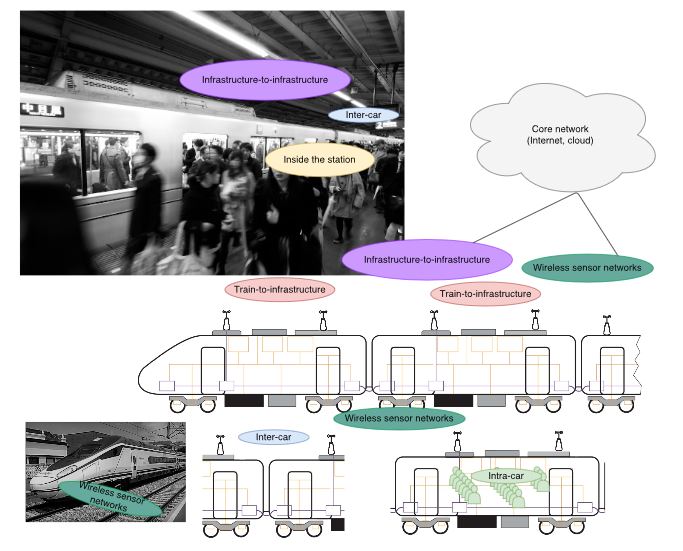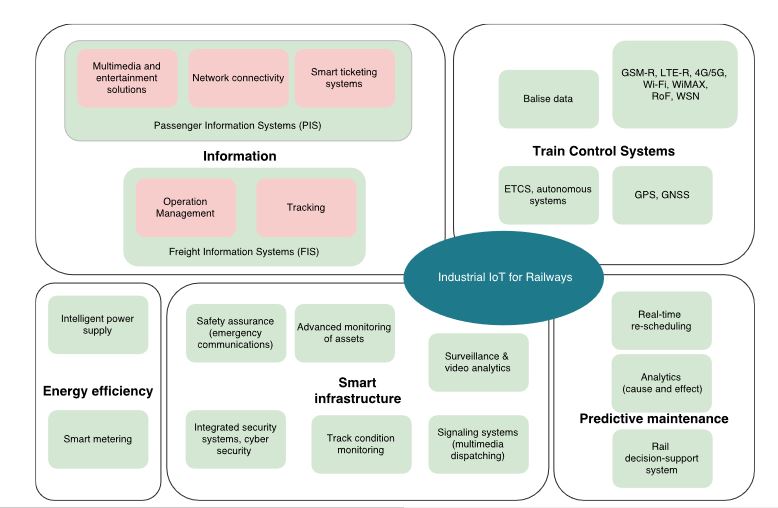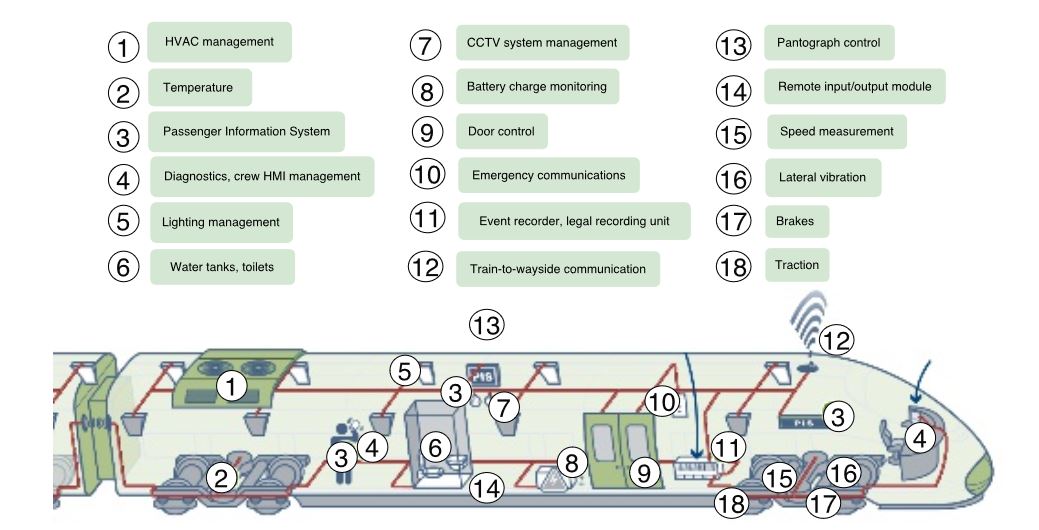ABSTRACT
Nowadays, the railway industry is in a position where it is able to exploit the opportunities created by the IIoT (Industrial Internet of Things) and enabling communication technologies under the paradigm of Internet of Trains. This review details the evolution of communication technologies since the deployment of GSM-R, describing the main alternatives and how railway requirements, specifications and recommendations have evolved over time. The advantages of the latest generation of broadband communication systems (e.g., LTE, 5G, IEEE 802.11ad) and the emergence of Wireless Sensor Networks (WSNs) for the railway environment are also explained together with the strategic roadmap to ensure a smooth migration from GSM-R.
Furthermore, this survey focuses on providing a holistic approach, identifying scenarios and architectures where railways could leverage better commercial IIoT capabilities. After reviewing the main industrial developments, short and medium-term IIoT-enabled services for smart railways are evaluated. Then, it is analyzed the latest research on predictive maintenance, smart infrastructure, advanced monitoring of assets, video surveillance systems, railway operations, Passenger and Freight Information Systems (PIS/FIS), train control systems, safety assurance, signaling systems, cyber security and energy efficiency. Overall, it can be stated that the aim of this article is to provide a detailed examination of the state-of-the-art of different technologies and services that will revolutionize the railway industry and will allow for confronting today challenges.
COMMUNICATION SYSTEMS IN RAILWAY SCENARIOS

Figure 2. Railway communications scenarios
Railway lines can be categorized mainly into one of four classes: urban, urban/inter-city, inter-city and/or high-speed. It is necessary to analyze lines or networks separately, given that their differences may have impact on their requirements (Table 1). Furthermore, railway communication systems can be divided into three main application groups: safety and control, operator, and customer oriented networks. In this Section, the communications in the most representative railway scenarios(Figure 2) are described: train-to-infrastructure communications, inter-car communications, intra-car communications, communications inside the station, infrastructure-to-infrastructure communications, and wireless sensor networks. In the following subsections, future directions of wireless systems in railways are addressed.
OVERVIEW ON THE RAILWAY APPLICATIONS OFFERED BY GSM-R
The Union Internationale des Chemins de Fer (UIC) selected the GSM technology after comparing it with TETRA in terms of usability in railway scenarios. Moreover, GSM was supported by the GSM Association (GSMA) and it was standardized by ETSI as GSM Release. After a thorough analysis, GSM-R was eventually standardized by the European Railways and the UIC. In Europe, a relevant initiative for the evolution of the communications was the European Integrated Railway Radio Enhanced NEtwork (EIRENE) project. This cooperation was participated by the European Commission (EC), ETSI and several railway operators. EIRENE was aimed at specifying the requirements for railway mobile networks.
LONG TERM EVOLUTION (LTE): ONE STEP AHEAD OF BROADBAND COMMUNICATION SYSTEMS
As a narrow band system, the main GSM-R shortcoming relates to its limited provision of advanced data services due to its lack of packet-switched transmissions (Table 7). For instance, in order to deliver burst low-rate ETCS data, connections need to take network resources continually even though not being used. The maximum transmission rate of GSM-R per connection is 9.6 kbps and the packet delay is in the range of 400 ms, which is sufficient only for applications with low demands.
The Rise of the Internet of Trains
Long before IoT was coined, railway operators and infrastructure managers were actively using M2M technology and data analysis to improve the maintenance and performance of their assets. The IIoT has had a major impact on the transportation industry, with the advent of autonomous vehicles and improved cargo management. Nevertheless, although they may have been pioneers, the reality is that the rail industry has barely scratched the surface of what is possible. As IIoT continues to evolve, it is bringing greater standardization, openness, and scalability to the information provided to operators: they gain insight into how their assets are performing, which opens up many new possibilities to use big data in more creative and effective ways.
IOT-ENABLED SERVICES: FROM MORE EFFICIENT OPERATIONS TO NEW BUSINESS MODELS

Figure 3. Industrial IoT-enabled services relevant to the rail industry
Legacy infrastructure is gradually being replaced by Train Management Systems (TMS), which transform trains in communications hubs that exchange data among them and with network control centers. Moreover, M2M communications allow operators to optimize and make safer use of equipment and infrastructure. The following subsections describe examples of IIoT-enabled services (a general vision is shown in Figure 3).
Sensors can be used to decrease the failure rate and enhance the reliability of trains, signals, and tracks. Such sensors are able to monitor equipment with the objective of generating alerts about the need for attention on critical elements of the train. In this way, costs are decreased and asset usage is optimized by lowering the number of trains taken out of service for inspection, preventive maintenance, or for replacing certain parts after a deficiency is detected. The most common systems to be monitored are represented in Figure 4.
CONCLUSIONS
This survey examined the role of enabling technologies to revolutionize the railway industry. Broadband technologies, like LTE, provide the capacity needed to create novel services. A formal analysis regarding GSM-R requirements and services was presented to provide an understanding of future customer needs. LTE Release 11 includes the first feature for public safety (i.e., high-power UE). Starting from LTE Release 12, the standard adds characteristics such as IMS emergency calls, ProSe, PoC, GCSE, and eMBMS that will evolve LTE/LTE-A to be used as part of a broadband public safety network. LTE Release 13 includes the first set of specifications for mission-critical scenarios including MCPTT, enhancements of ProSe and GCSE, and the isolated E-UTRAN operation.
Although the feasibility of LTE in the railway environment is evaluated, the deployment of a brand-new ecosystem will also require the design of a thorough migration strategy. In addition, WSNs constitute an essential part of the protection of the infrastructure, and M2M technology can boost efficiency by using sensors embedded into objects and systems to deliver real-time analysis and monitoring while enabling automation. The fast pace of ICT technologies (e.g., cloud computing and big data) and communication networks enable the adoption of Industrial IoT to integrate the thousands, if not millions of components, from rolling stocks to the station.
The Internet of Trains paradigm holds the promise that rail systems can leapfrog interoperability, safety, and cyber security issues, while modernizing rapidly. It refers to the use of networks of intelligent on-board devices connected to cloud-based applications to improve communications and control systems. The same network that strengthens safety has enough capacity to deliver enhanced data that serves a variety of applications across the rail system to reduce costs and improve operations. Furthermore, the adoption of the paradigm opens a wide area of short and medium-term potential applications.
Examples like predictive maintenance, smart infrastructure, advanced monitoring of assets, video surveillance systems, railway operations, Passenger and Freight Information Systems (PIS/FIS), train control systems, safety assurance, signaling system, were detailed in order to expose the IoT capabilities to reinforce competitive advantages, to create new business models, and to change railways. For each of the services, the latest technologies and the main academic and commercial developments were thoroughly examined. After all the analyses performed, it can be stated that the Internet of Trains and IIoT still face many challenges, such as standardization, interoperability, scalability, energy efficiency and cyber security, which would have to be addressed by researchers that will have to cope with the additional issues posed by railway environments and the specific nature of the operations and the networks.
Authors: Paula Fraga-lamas | Tiago M. Fernandez-carames | Luis Castedo
>> 200+ IoT Led Projects for Engineering Students
>> More Wireless Sensor Networks Projects Abstract for Engineering Students
>> More Wireless Embedded Projects for Final Year Students
>> More Wireless Energy Projects for Final Year Students
